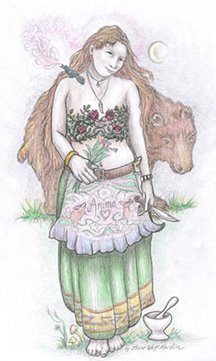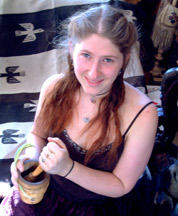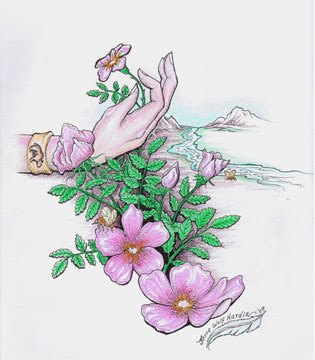 We’ve all seen those ads in slick alternative health magazines pushing Goldenseal as an “herbal antibiotic”, and we’ve read those generic herb articles proclaiming the next miracle herb that “studies show” will cure arthritis, build sexual endurance, give you energy when you haven't slept in a week, help you win the lottery and give you a slim, youthful figure. These commercial, and often ignorant, generalizations can make the most tolerant herbalist cringe. What practicing plant people know best is that each herb has an individual spirit and personality that makes it entirely unique unto itself. Sure you can use Cinquefoil instead of Rose to tighten up tissues, as they are both rose family astringents, but on an plant to person level, the effects can be totally different. Cinquefoil is about releasing tension and asserting one’s true self, while Rose helps us open up and cool anger. So in order to best address the ~whole~ person, we search for just the right plant for person and situation.
We’ve all seen those ads in slick alternative health magazines pushing Goldenseal as an “herbal antibiotic”, and we’ve read those generic herb articles proclaiming the next miracle herb that “studies show” will cure arthritis, build sexual endurance, give you energy when you haven't slept in a week, help you win the lottery and give you a slim, youthful figure. These commercial, and often ignorant, generalizations can make the most tolerant herbalist cringe. What practicing plant people know best is that each herb has an individual spirit and personality that makes it entirely unique unto itself. Sure you can use Cinquefoil instead of Rose to tighten up tissues, as they are both rose family astringents, but on an plant to person level, the effects can be totally different. Cinquefoil is about releasing tension and asserting one’s true self, while Rose helps us open up and cool anger. So in order to best address the ~whole~ person, we search for just the right plant for person and situation.
Modern Western herbalism has been partially built around the allopathic mindset of “this herb for this problem”, touting immune stimulants as the answer cold and flu, and chinese tonic herbs as the herbal remedy for impotence. Sometimes this approach can work, often Echinacea will help someone avert coming down with a cold, or Ginseng will give them the energy boost to keep on trucking through bad jobs, a divorce and bankruptcy but in neither case do the herbs actually heal, because they don’t address the underlying systemic weakness. And in fact, they make actually do harm, allowing a person to do more damage to themselves instead of dealing with the actual state of their whole self. What we’re lacking is an understanding of how to use specific herbs for specific people and specific imbalances. While Goldenseal does indeed act as an anti-bacterial, that doesn’t necessarily make it ideal for treating all bacterial infections. Another example would be of classifying both Boldo and Vervain as “liver herbs”. They both affect the liver, but how do they affect the liver? Boldo stimulates the liver, but Vervain relaxes it, making Boldo useful in cases of a cold, sluggish, underperforming liver that results in PMS, bad skin and digestive headaches. Vervain, on the other hand, is ideal for people with inflamed, overheated livers that cause red eyes, insomnia, nervousness and a tendency to easily anger. In my previous posts on Herbs for headaches and for injuries, I’ve tried to include a few hints on how to most specifically apply each herb. Unlike the “this herb for that problem” style of herbalism where students can memorize charts of illnesses and corresponding herbs, specific medicines require our direct participation in the process. For each person, there is an herbal helper. When we can approach healing from the standpoint of wholeness, we realize we don’t need to worry so much about the definition of the pathology, or the chemistry of the remedy. Instead, we can take the time to focus on the relationship between person and herb, working as a matchmaker rather than a fixer.
Specific medicine has to do with a general sense of energetics and actions, but it has more to do with the very particular qualities of each individual herb. While energetics can teach us how to find a certain subset of herbs for a problem (using pelvic oriented blood movers like Rose or Peony or Salvia root or Mugwort for ovarian cysts), specific medicine can help us find the exact herb for that particular person and problem (using Rose for a woman with ovarian cysts who’s been sexually abused, has an overheated, moist constitution and an inability to express love). While we can generally be assured of overall good results simply using a broadly energetic approach, the most profound results will be seen when we find the “perfect” herb for a person. I think this has been shown most dramatically in flower essences where each essence is accompanied by a clear emotional/spiritual symptom picture, or in the specific indications of the Physiomedicalist’s literature. As an example, here is an excerpt from William Cook’s excellent The Physiomedicalist Dispensatory on Dandelion:
Properties and Uses: The root is a mild laxative and alterant, of the relaxing-tonic grade, slowly and gently influencing the liver, small intestines, and kidneys. It is most useful in mild grades of chronic hepatic obstruction and torpor, with biliousness and weakness of the stomach; in engorgements of the liver and spleen, and abdominal dropsy dependent on these conditions. Though slow. in action, it is well received by the system; and if gathered at the proper season, and used in cases not too degenerate, it deserves consideration, though concentrated preparations are required. When the stomach or bowels are irritable, it should not be employed...
Ideally, we include emotional and spiritual indications as well. We can look to others’ experiences hints and tips on how to approach an herb, and sometimes we can actually get a very good idea of the situation and person who might most need the plant. But to really understand the inner workings and subtle details of each plant we need to interact with the plant ourselves. The best plant to person relationships are built by spending time with the plant, watching it in all seasons, smelling and tasting it, and then trying it over and over again. Most of all, it requires that we listen to what the plant is trying to tell us. There have been many times when I’ve heard the name of a plant over and over in my head even when all my book knowledge and common sense has indicated otherwise. Once, while experience a week long bout of restless insomnia that none of my regular herbal allies seemed to be able to help me with, I got a very strong urge to dig out my one ounce of St John’s Wort tincture, a plant I hadn’t even previously worked with at all, and that is rarely indicated for insomnia. Sure enough, two drops of St John’s Wort allowed me to sleep peacefully all night, and put an end to further instances.
While learning to accurately intuit the right herb for each person can seem intimidating and suspiciously spiritual to some, much of the process is defined by common sense and experience. Most important is the perspective of the practitioner, with a strong focus on intimacy with both plants and people.
A few introductory tips:
1) Intimacy: Get to know just a few plants at a time. As with people, it’s much easier to be intimate with an individual than with a whole dinner party.
2) Exploration: Spend time exploring the subtleties of each plant. Don’t just focus on that plant’s primary strength, or you could miss the larger picture of how that plant might effect someone. You may not think of Sage an herb for anxiety or depression, but she might surprise you.
3) Participation: Connect with the plant on a personal level, and allow that plant to permeate your life, dreams and thoughts. In many ways, getting to know a plant is much like getting to know a lover. And you can’t become acquainted with either from a distance.
4) Wonder: Remember to be amazed. It’s easy for some of us to become cynical or jaded after reading piles of scientific journals, constituent reports and case studies. Cultivate the joy and magic of the plants in your daily life by staying in close physical contact with them through taste, touch and sight. You can’t get to know the plants through books, lectures or the web...
There are no hard and fast rules to herbal medicine but for some excellent guidelines for using specific medicines, turn to the Physiomedicalist/Eclectic herbalists of yesteryear such as John Scudder, Finley Ellingwood, William Cook and T. J. Lyle. Many of their writings can be found at the websites of Michael Moore & Henriette Kress. And for the best modern resource for understanding specific medicines, check out Matthew Wood’s books. Also see my herb links on the right hand bar, as most of my favorite herbalists have a firm foundation in herbal intimacy and specific medicines.












4 comments:
It's really quite amazing how as healers we can recieve intutions about the "specific" plant remedy that will be helpful for someone. It happens to me all the time, sometimes the name or picture of plant will just pop up when thinking of a certain person....and often I can't pinpoint WHY that is THE herb for them, but inevitably, I give the herb, and it is just what was needed by that person at that time.
That said, I think it is important not to discount the ability of single plants with certain energetics to be helpful without being "specific" medicines. As modern herbalists we have access to and information about HUNDREDS of plants, all of which could be useful to someone with certain conditions. But traditional healers often have a repetoire of 20-30 plants, and may not be able to select the perfect astringent from among 10 different astringents...they may just use the astringent that grows down by the bend in the river closest to their home.
Both methods are useful, and in different situations and places. Wonderful explanation though, especially the how-to of learning about plant personalities. Sleeping with your herbs is a wonderful, magical way to learn about the energy and spirit of a healing plant.
I'm often asked how I can remember so many plants...and I always explain, they are like people, with unique personalities and qualities that make them unique. It isnt' hard to distinguish among all your blue eyed friends, because you know their quirks and specialities...plants are the same way.
Ahhh, wonderful. Very well said Kiva. I like your ability to be specific without being overwhelming. Great tips! I think this (multi-level)intimacy really helps with knowing how much of the herb to use. Just dreaming with it may be enough, or you may find you wake with a hunger to eat a bowl full of it!
ananda
Yay, thanks for the comments, Darcey and Ananda!
I definitely agree with what you're saying Darcey. And I am one of those herbalists who generally stick to about 20-30 plants for most purposes, I think perhaps I was writing with the basic assumption that someone would choose from the plants near them (must be careful not to assume things lol). I do think that almost always the plant you most need will grow nearby. Not always, but usually.
I'm glad we have the hundreds of herbs available to us, but I do think it's important to focus on local, commonly available herbs for nearly any situation. As with food, I feel that locally obtained herbs will work more synchronistically for both the healer and the person using the herb. And I think that that's why our common urban weeds like dandelion, burdock and mallow are so broadly useful to the majority of our culture (but THAT is a whole nother post all on it's own.
I think I will do my next post on ways of getting intimate with plant allies. Thanks for your suggestions, Darcey & Ananda.
Wow, we all have energetics on our minds right now, don't we? It's so cool to read your post and Darcey's post after I just wrote about paying attention in herbal practice -- the same topic, really. Cross fertilization is lovely. (And here we are the three of us again... Ananda, when are you going to start an herbal blog?)
Post a Comment